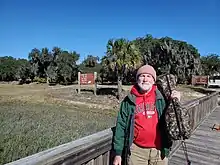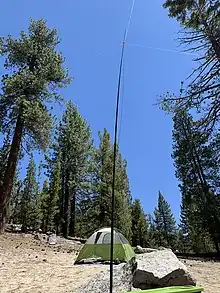| Abbreviation | POTA |
|---|---|
| Formation | January 5, 2018 |
| Type | Nonprofit |
| Registration no. | 82-3908364 |
| Purpose | Radiosport |
| Headquarters | Severna Park, Maryland |
| Website | parksontheair |
Parks on the Air (POTA) is an international radiosport award program that encourages licensed amateur radio operators to visit, enjoy and operate portable equipment in a variety of parks and public lands, always respecting other park users and local regulations.[1][2] POTA issues awards to participants based on a wide range of criteria including the total number of radio contacts made, number made on each amateur radio band, and for different modes of communication including voice, Morse code or FT8.[3][4][5]
History
The POTA movement began in the United States. It built on the surge of interest in portable radio operation caused by the ARRL hosting a one-year program called NPOTA in 2016[6] to celebrate the 100th anniversary of the National Park System.[7][8] A nonprofit organization was founded in 2018 to continue POTA on a permanent basis, since when it has been a popular method of community and student outreach,[9] with events taking place both in parks and sometimes at other public events.[10][11][12] The organization worked to expand worldwide and participation now occurs around the clock and around the world, in locations as diverse as the Caribbean,[13][14] India,[9] China and Europe. Park locations range from large national parks covering many square miles to small urban locations and islands.


Participation
Amateur radio operators who set up a temporary station at a park are known as activators, while others who 'spot' and complete contacts with them are called hunters.[15][3] Activations can take place on the initiative of an individual operator, or as part of organized group events such as Field Days.[12] Equipment used is typically small, battery operated, and may have been constructed by the operator themselves. The radio may be hand-held, carried in a backpack or a 'go box', or it could be mounted in a vehicle, as permitted by the park operator. Antennas may be small enough to form part of a hand-held unit for VHF and UHF operations, or be ground-spike or tripod-mounted temporary whips or loops for longer radio wavelengths. Where permitted by local regulations, kites, trees or lightweight masts and fishing poles are sometimes used to suspend wire antennas as high as possible to optimise performance. In this way, with patience, skill, and good luck with propagation conditions, contacts can sometimes be made worldwide using radios little larger than a pack of playing cards, although some activators prefer to use higher power, more sophisticated and larger equipment.
Activators can signal their intent to be on the air in advance using the POTA website, so that hunters are ready for them. Activators log all the contacts they make and upload them to the POTA website, which then allocates the rewards and shows league tables for everyone involved. A successful activation requires a minimum of 10 contacts (QSOs) from a park in the designated list within a single UTC day (Zulu day).
See also
References
- ↑ Kiaski, Janice (2022-02-05). "Paul Brandt: The POTA guy". Weirton Daily Times. Archived from the original on 2022-10-20. Retrieved 2022-10-20.
- ↑ Fury, John (2020-04-24). "Amateur Radio, Not Just a Hobby". Virginia Department of Conservation and Recreation. Archived from the original on 2022-10-20. Retrieved 2022-10-20.
- 1 2 "POTA (Parks on the Air) Overview". OnAllBands. 2019-08-23. Archived from the original on 2022-10-20. Retrieved 2022-10-20.
- ↑ 16 - Parks on the Air with Don W1FYG, 2021-03-29, archived from the original on 2022-10-20, retrieved 2022-10-20
- ↑ "POTA Awards". Parks On The Air. Archived from the original on 2022-10-20. Retrieved 2022-10-20.
- ↑ Szewczyk, Kimberly (2016-06-18). "National Parks on the Air - Women's Rights National Historical Park (U.S. National Park Service)". National Park Service. Archived from the original on 2022-10-20. Retrieved 2022-10-20.
- ↑ "NPOTA Participation Leads to Inaugural Communication Detail for National Park Service". American Radio Relay League. 2017-01-27. Archived from the original on 2022-10-20. Retrieved 2022-10-20.
- ↑ "It's World Amateur Radio Day!". American Radio Relay League. 2016-04-16. Archived from the original on 2022-10-20. Retrieved 2022-10-20.
- 1 2 Vagadia, Rajesh (2022-09-28). "University students learn about Amateur Radio Satellites". Southgate Amateur Radio News. Archived from the original on 2022-10-20. Retrieved 2022-10-20.
- ↑ "Amateur Maple Ridge radio club bringing back popular swap meet - Maple Ridge News". Maple Ridge-Pitt Meadows News. 2022-03-29. Archived from the original on 2022-10-20. Retrieved 2022-10-20.
- ↑ "Amateur Radio Takes Center Stage at The Big E". American Radio Relay League. 2022-09-15. Archived from the original on 2022-10-20. Retrieved 2022-10-20.
- 1 2 "Club de radioamateur VE2CWQ : un hobby qui a plus que jamais sa pertinence". L'Oeil régional. Archived from the original on 2022-10-20. Retrieved 2022-10-20.
- ↑ "Youlou Radio Movement hosts second 'Summit on the Air'". www.searchlight.vc. 2022-02-01. Archived from the original on 2022-10-20. Retrieved 2022-10-20.
- ↑ DeRiggs, Donald (2022-01-25). "YOULOU Radio Movement turns 27". www.searchlight.vc. Archived from the original on 2022-10-20. Retrieved 2022-10-20.
- ↑ "Home". Parks on the Air Documentation. Archived from the original on 2022-10-04. Retrieved 2022-10-20.